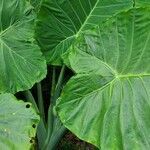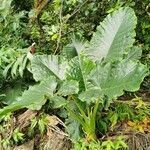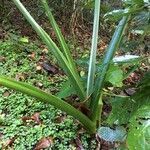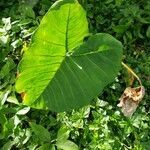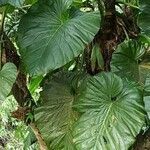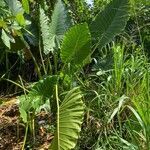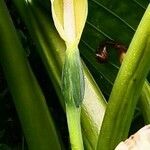Pachycaul herbs, massive, to 4 m, evergreen, latex slightly milky. Stem erect, to ca. 1.5 m, decumbent. Leaves several together, clustered at tips of stems in larger plants; petiole to 1.3 m, sheathing in proximal 1/3-1/2; leaf blade light green on both surfaces, ovate-sagittate, bluntly triangular, up to 120 × 50 cm, ± erect, margin entire to very slightly sinuous; posterior lobes 1/3-1/2 length of anterior, somewhat rotund, often overlapping, naked in sinus in mature plants, weakly peltate in juveniles; primary lateral veins ca. 9 on each side of anterior lobe, axillary glands distinct, secondary venation not forming interprimary collective veins. Inflorescences paired among leaf bases, subtended by membranous cataphylls; peduncle barely exceeding cataphylls at anthesis. Spathe 13-35 cm, constricted ca. 1/6 from base; proximal spathe green, ovoid; limb cowl-like at anthesis, later reflexed, then deliquescent, pale yellow, broadly oblong-lanceolate, 10.5-29 cm. Spadix slightly shorter than spathe, shortly stipitate; female zone conic-cylindric, 1-2 × ca. 1.5 cm; pistil pale green, ca. 3 mm in diam.; stigma yellow, sessile, 3-5-lobed; sterile zone slightly equaling female zone, whitish; synandrodes rhombic-hexagonal, ca. 2.5 mm in diam.; male zone whitish, cylindric, 3-7 × ca. 2 cm; synandria 5-9-merous, rhombic-hexagonal, convex-topped, ca. 2 mm in diam.; appendix yellowish, slightly tapering, at least 1/2 length of spadix. Fruiting spathe green, oblong-ellipsoid, ca. 8 cm. Fruit ripening scarlet, ellipsoid, ca. 12 × 8 mm.
More
Massive, arborescent, erect to decumbent herb; rhizome to c. 15 cm diam. Leaves: petiole to c. 1 m long, green, occasionally mottled brown; blade sagittate, to c. 1 m long, often with margin very shallowly undulate; posterior lobes rounded; secondary venation slightly raised abaxially, not forming interprimary collective veins. Inflorescences on short peduncles almost concealed within subtending cataphylls and leaf bases; spathe c. 13–35 cm long, constricted c. 1/6 of way from base; limb membranous, pale yellow, cowl-like then reflexed, deliquescent and deciduous; spadix slightly shorter than spathe; female zone 1–2 cm long, separated from male zone by a short hardly attenuated sterile interstice; male zone of ±isodiametric few-stamened synandria; anthers opening by short longitudinal slits, the thecae concealed from above by outgrowth of the synconnective; appendix slightly thicker than male zone, then tapering distally, equalling to exceeding 1/2 length of spadix.
A very large herb. A taro family plant. It has a stout erect trunk up to 4 m tall. This has upright leaves which are arrow shaped. Leaves have round lobes at the bottom. The leaves are leathery and are often wavy around the edge. The secondary veins are not prominent. The leaf blade can be 1-1.2 m long. The leafy structure around the flower is yellow in the upper section. It forms a hood and drops off as the flower opens. The fruit are bright red berries. The corm is large, often curved and above the ground. It often has small cormels at the side. Brown trailing fibres of the leaf bases often hang from the stem. The leaves and petioles contain stinging crystals.
The top of the main corm is planted. The small round cormels can be planted, but are slow to mature. A spacing of 1.2 x 1.2 m is suitable. Because the giant taro takes more than a year to be ready to harvest, it often ends up left growing in an old garden site without much care or weeding, until the owner wants to harvest it. The mouth can be irritated by chewing improperly cooked plant parts due to chemicals called oxalates. Giant taro contains small needle-like calcium oxalate crystals in the tissues. It is necessary to remove these during the preparation and cooking. The method of peeling is important. Normally some ladies who are especially experienced at peeling do this job. Also the taro corm is often left to wilt for a week after it is harvested and before it is used. Also to help remove some of the crystals, the stem is baked for a long time, or boiled in several changes of water. It is also important to use the right variety of giant taro because the kinds grown in gardens have less of the chemical than wild ones.
